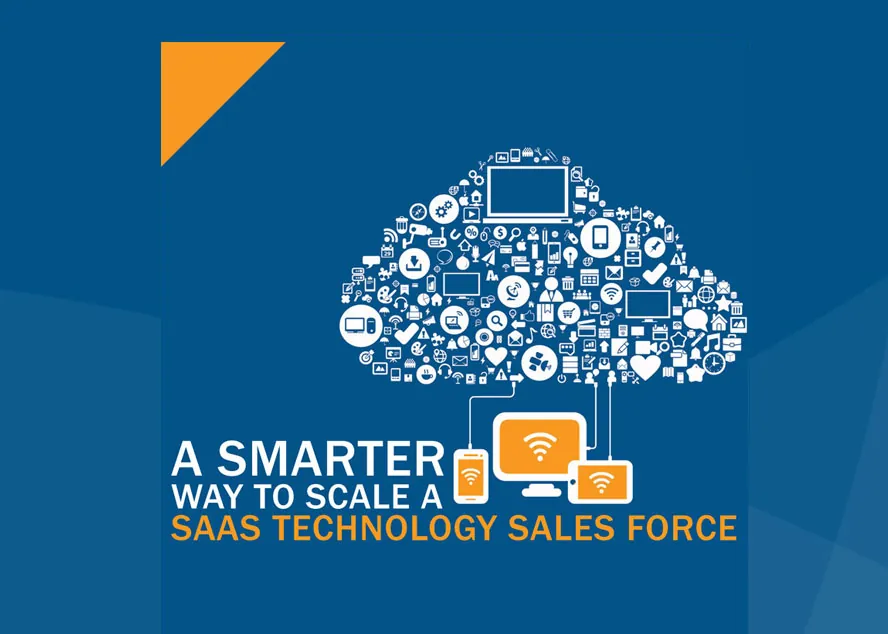How to Sell B2B SaaS More Effectively

When a customer has a real problem, they only care about solving it. When buying SaaS, customers are buying a service that solves their business problems. They are not buying software. If SaaS customers are not buying software, why do sales reps spend so much time selling software features? This article explores how leading SaaS companies approach sales and what SaaS sales reps can learn from them.
If you ever had the mind-numbing experience of sitting through a software presentation where the sales rep only talked about software features, you understand the problem. The SaaS sales rep becomes hypnotized by their own voice and dives through an entire demo without coming up for air. Their first question is, “So what did you think?” at the end of their demo.
The average sales rep hopes that if they cover enough software features, the prospect will figure out how the software will solve their business problem. The best SaaS sales reps, on the other, hand are masters at solving business problems and executing presentations demonstrating proof of value (POV). Let’s explore this deeper.
Expected Return vs. Investment
The sale will close itself when logical buyers believe their expected return will be greater than their investment. In other words, the seller has to demonstrate enough proof, so that the buyer says yes because the proof of the expected return is greater than the investment.
Believe it or not, there are B2B SaaS companies that struggle to sign-up customers with free service. Why? Because the buyer does not believe the value is worth the cost to switch.
For example, we recently worked with a potential client considering us for sales training and our sales reinforcement service, Janek Xpert. We provided a proposal for $40,000, which their CFO said was out of budget. The first question we asked was, “How familiar are you with the business issue we’re solving with this proposal?”
His response was, “I’m very familiar. We are looking for a sales training company to help us onboard our new sales reps. But it’s not worth $40,000.”
“Okay, let’s double check our proposal,” we asked. “Can we walk you through how we came up with the number working with your VP of Sales?
“Sure,” was his reply.
“Your VP of Sales said that your current sales rep onboarding process takes six months. After six months, your average sales rep produces about $10,000 in monthly recurring revenue, which is break even on the hiring investment for your company. Is that correct?” we asked.
“That sounds about right,” he responded.
“Your VP of Sales also informed us of your plan to scale your sales team by a minimum of 40 new reps in the next six months.”
“Correct. That’s the plan.” was his reply.
“So, if we onboard those 40 new sales reps two months faster using our sales coaches, sales trainers, and Janek Xpert, that would result in an expected return of 40 sales reps x $10k MRR x 2 months faster. Our math says that will be an $800,000 revenue increase compared to a $40,000 investment.”
As you can see, we had a quantified business problem. The math checked out with the CFO, and they felt the pain of doing nothing with their current challenges.
Because our presentation was focused on their challenges and how we could solve their business problem, the contract was signed the same day. When the expected return is 20x greater than the investment, even the most frugal CFO will have difficulty saying no.
In this, it’s easy to see how a SaaS-specific sales process can help close deals. Folio lists several aspects of an effective B2B SaaS sales process. Briefly, they note:
- Tailoring your approach to the company’s unique software needs
- Mapping your SaaS customer’s stages
- Incorporating SaaS-specific criteria into your ideal customer profiles (ICPs)
- Establishing consistent and efficient SaaS sales approaches
- Empowering sales teams with SaaS knowledge and techniques to differentiate themselves from the competition
- Fostering greater alignment and collaboration between sales and marketing to create specific SaaS content and sales approaches
In addition, AppDirect suggests a highly targeted app portfolio. This includes their “land, engage, and expand” approach:
- Land customers with cloud services that align with your business and simplify your value proposition
- Engage customers with comprehensive onboarding that includes websites and tutorials
- Expand your catalog with specialized applications, such as security upgrades
Further, they suggest reaching new markets by:
- Leveraging partners to distribute your products and services
- Prioritizing providers that support a broad range of services
- Targeting services for different buyer segments
Moreover, Lusha suggests four tactics to successfully sell to SaaS customers. These include:
- Adjusting trial periods to complexity of the deal
- Providing effective demoing and onboarding
- Pursuing customer feedback
- Timing renewals and releases
An app like scheduling is easy enough and may require a week to adjust. However, when integrated with payroll and inventory, it can become complex. For complex SaaS offerings, consider trials of a month or more.
Customize demos to address specific pain points. However, with self-service a key preference, consider supplemental onboarding materials.
In SaaS, feedback is crucial. With less complex packages, many customers may not even mention issues. Instead, they may simply stop using your service. No matter the issue, care and attention are as vital to customer service as enlisting the right support.
As new customers may waver on commitment, monthly subscriptions can help. However, with large, financially stable customers, consider discounted annual subscriptions. Also, tie renewals and upgrades to new product releases to drive upselling and cross-selling opportunities.
Price Resistance
When presenting proposals to SaaS buyers, very often, buyers are shocked at the price. Where does this price resistance originate? When we break it down, price resistance can only arise from one of three sources:
- Lack of belief that the return can be delivered
- Negotiating a better deal
- Inability to pay
The best SaaS companies are masters of proving they can deliver that value. The best SaaS sales reps are masters at discovering business challenges. The better the sales rep discovers real business challenges, the fewer negotiations are necessary. We have found that an in-depth discovery process and fewer negotiations are linked. Here’s how:
Very often, organizations come to us and say, “Our sales reps need help doing a better job negotiating. We have a lot of deals in the pipeline, but we are getting beat up on price.”
Once we audit their entire sales process, we often find the root cause is in their discovery process. The symptom of a poor discovery process are drawn-out negotiations. Discovery includes ensuring the sales rep identifies the ideal customer and organizes their proposals in such a way as to articulate the proof of value to the organization.
The result of getting these two steps right is shorter sales cycles. Prospects tend to move quickly when they believe you can solve their business problems. The less belief they have in the company’s ability to solve the business problem, the more negotiations will be required by the sales rep.
Once you discover need, it’s essential to provide a solution to address that need. But to close deals, solutions must provide value to justify the cost. Hence, the value proposition of any SaaS solution is crucial to its price. Let’s take a look.
Value Propositions in SaaS Negotiations
In any negotiation, price may be the elephant in the room. But value is the ghost in the machine. To achieve successful win-win B2B SaaS negotiations, these two entities must align. In SaaS, with costs rising in tandem with complexity, sellers must emphasize value before addressing price. This is not always easy.
In SaaS, AppDirect says this starts with creating personalized buying journeys to attract, engage, convert, and retain customers. This includes knowing their needs and personalizing solutions.
Today, value starts with meeting the customer’s buying preferences, and this makes omnichannel crucial. Sellers must also leverage predictive analytics to align customer needs and preferences. And they must hyperpersonalize marketing to demonstrate value. Thus, value and customer satisfaction are at the forefront of any SaaS price negotiation.
For Folio, a compelling SaaS value proposition addresses specific industry challenges and how your solution solves it. Further, it must show how it differs from the competition. For example, is it faster and more scalable? Is it easier to use? In SaaS, these are key differentiators that help offset price objections.
In addition to justifying cost, the right value proposition can shorten the sales cycle. Here’s how:
Shorter B2B Sales Cycles
The best SaaS reps have shorter sales cycles. It’s not that they can type quicker, talk faster, or have more sales activity. The highest-performing sales reps we’ve worked with don’t write perfect emails or have an irresistible secret voice-mail script. Most importantly, they are not the ones with the most activity logged in the CRM. This is what we call the mistake of more activity.
The best-performing SaaS sales reps move with precision. They have a system, and they follow a process. This framework provides efficiency. They also realize that their efficiency suffers if they deviate from the process.
They realize there is too much on the line to ramble through the sales process. This requires discipline, which is the intangible to high-performance sales, not just more activity.
Yet, all too often, average sales reps ramble through the sales process. They receive a lead from marketing, do very light discovery and even less qualifying, and jump into a sales presentation. They have a pipeline full of late-stage deals that don’t close. The only thing that fixes this is accountability. Otherwise, it becomes ingrained into the sales culture.
This is where a lot of sales organizations stay average. They underestimate the cost of doing nothing. They either rely on a sales process that was not planned with precision, or they slacked on accountability and created a culture that tolerates mediocracy. It’s a commitment to accountability that solves this dilemma.
B2B SaaS Sales & Marketing Mix
The best SaaS B2B companies have tightly aligned sales and marketing operations. Sales need a steady stream of qualified leads while adhering to their sales process. Marketing needs to attract the ideal customers, not just any customer. When these two departments work in sync, hockey stick revenue growth is the likely result.
Synchronizing sales and marketing requires a clear understanding of each other’s goals and how they can help each other achieve those goals. When everyone is on the same page, achieving growth targets is much easier. When sales and marketing are not on the same page, sales struggle.
Very often, what marketing views as the total addressable market and what sales views as their ideal customer profile are two different numbers. This means that salespeople are often working with leads that should not be in their pipeline. The undisciplined sales rep might even close the lead at a discounted price.
However, this customer churns 2x faster than average because they were not a good fit. If the sales team is going to be held accountable for adhering to the sales process, the marketing team must be held accountable for delivering qualified leads.
B2B Lead Generation
For SaaS sales strategies, identify those customers most likely to benefit from the product or service. This often means customizing to meet their specific needs. And it requires generating leads through more channels than traditional selling, like cold calling, email campaigns, and SEO. In SaaS, this must be broader, such as:
- Pay-per-click advertising (PPC)
- Interactive webinars and seminars
- Content marketing
- Referral programs
- Social media
- Other paid advertising avenues
Effective SaaS sales funnels must deliver high-value content and a clear value/ROI proposition. Therefore, lead gen efforts should establish credibility and illustrate how your products/organization are leaders in your space.
Outbound Activities
Further, in SaaS, prospecting must incorporate a greater mix of inbound and outbound activities. Here, sales teams seek potential customers from within a more specific target market. This requires more diverse touchpoints, both digital and face-to-face. These must cultivate interest in the product and foster meaningful relationships.
Outbound prospecting encompasses various techniques, such as:
- Initiating cold calls to target high-priority customers
- Leveraging more specific email marketing campaigns
- Harnessing social media platforms like LinkedIn
Sales Qualification
To enhance both the ROI of SaaS marketing efforts and customers satisfaction, companies must do more. This includes ensuring the unique prospect’s specific compatibility with their products, services, and cost. To achieve this, organizations should:
- Craft targeted questions to uncover specific SaaS challenges
- Understand the company’s budget in relation to need
- Position past products and services in relation to failures/weaknesses
- Demonstrate real value with specific measurable data/timeframes
Master SaaS Sales: Discovery to Negotiation
SaaS buyers are buying a service, and the service is problem-solving, not software. The sales cycle is short when the buyer believes the expected return is greater than their investment. When they question the expected return, sales reps find themselves in the “we need to think about this” stage of selling SaaS B2B.
The key to great negotiation starts with great discovery. When great discovery skills are combined with the discipline to follow a precise sales process and a well-synchronized marketing mix, high performance is the outcome. When these attributes are missing, SaaS companies find themselves swimming in a sea of mediocracy.
Elevate your performance from mediocrity to excellence with our comprehensive sales negotiation training program. Master the art of discovery, streamline your sales process, and synchronize your marketing mix for unparalleled results. Don’t let opportunities slip away—supercharge your negotiation skills and close SaaS deals with confidence. Enroll now and transform your B2B SaaS sales strategy.

- Account Planning (12)
- Awards (44)
- Client Testimonial (37)
- Personal Branding (21)
- Podcast (12)
- Research (78)
- Sales Career Development (90)
- Sales Coaching (166)
- Sales Consulting (141)
- Sales Culture (180)
- Sales Enablement (382)
- Sales Leadership (116)
- Sales Management (267)
- Sales Negotiation (14)
- Sales Prospecting (138)
- Sales Role-Playing (19)
- Sales Training (243)
- Selling Strategies (281)
- Soft Skills (78)
- Talent Management (101)
- Trusted Advisor (29)
- Virtual Selling (57)
- Webinar (13)

























